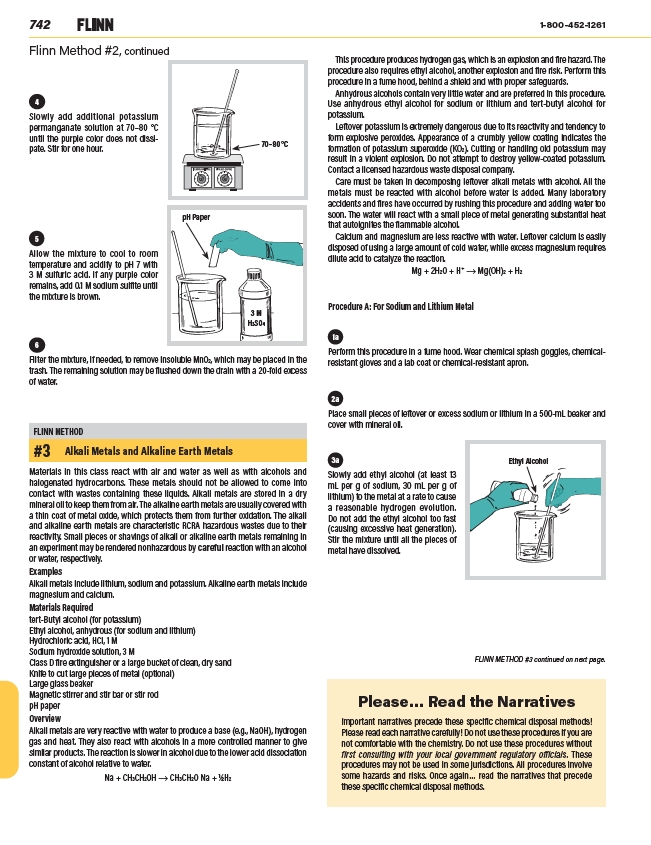
742 1-800-452-1261
6
Filter the mixture, if needed, to remove insoluble MnO2, which may be placed in the
trash. The remaining solution may be flushed down the drain with a 20-fold excess
of water.
FLINN METHOD
#3 Alkali Metals and Alkaline Earth Metals
Materials in this class react with air and water as well as with alcohols and
halogenated hydrocarbons. These metals should not be allowed to come into
contact with wastes containing these liquids. Alkali metals are stored in a dry
mineral oil to keep them from air. The alkaline earth metals are usually covered with
a thin coat of metal oxide, which protects them from further oxidation. The alkali
and alkaline earth metals are characteristic RCRA hazardous wastes due to their
reactivity. Small pieces or shavings of alkali or alkaline earth metals remaining in
an experiment may be rendered nonhazardous by careful reaction with an alcohol
or water, respectively.
Examples
Alkali metals include lithium, sodium and potassium. Alkaline earth metals include
magnesium and calcium.
Materials Required
tert-Butyl alcohol (for potassium)
Ethyl alcohol, anhydrous (for sodium and lithium)
Hydrochloric acid, HCl, 1 M
Sodium hydroxide solution, 3 M
Class D fire extinguisher or a large bucket of clean, dry sand
Knife to cut large pieces of metal (optional)
Large glass beaker
Magnetic stirrer and stir bar or stir rod
pH paper
Overview
Alkali metals are very reactive with water to produce a base (e.g., NaOH), hydrogen
gas and heat. They also react with alcohols in a more controlled manner to give
similar products. The reaction is slower in alcohol due to the lower acid dissociation
constant of alcohol relative to water.
Na + CH3CH2OH → CH3CH2O Na + 1⁄2H2
This procedure produces hydrogen gas, which is an explosion and fire hazard. The
procedure also requires ethyl alcohol, another explosion and fire risk. Perform this
procedure in a fume hood, behind a shield and with proper safeguards.
Anhydrous alcohols contain very little water and are preferred in this procedure.
Use anhydrous ethyl alcohol for sodium or lithium and tert-butyl alcohol for
potassium.
Leftover potassium is extremely dangerous due to its reactivity and tendency to
form explosive peroxides. Appearance of a crumbly yellow coating indicates the
formation of potassium superoxide (KO2). Cutting or handling old potassium may
result in a violent explosion. Do not attempt to destroy yellow-coated potassium.
Contact a licensed hazardous waste disposal company.
Care must be taken in decomposing leftover alkali metals with alcohol. All the
metals must be reacted with alcohol before water is added. Many laboratory
accidents and fires have occurred by rushing this procedure and adding water too
soon. The water will react with a small piece of metal generating substantial heat
that autoignites the flammable alcohol.
Calcium and magnesium are less reactive with water. Leftover calcium is easily
disposed of using a large amount of cold water, while excess magnesium requires
dilute acid to catalyze the reaction.
Mg + 2H2O + H+ → Mg(OH)2 + H2
Flinn Method #2, continued
FLINN METHOD #3 continued on next page.
Procedure A: For Sodium and Lithium Metal
1a
Perform this procedure in a fume hood. Wear chemical splash goggles, chemicalresistant
gloves and a lab coat or chemical-resistant apron.
2a
Place small pieces of leftover or excess sodium or lithium in a 500-mL beaker and
cover with mineral oil.
4
Slowly add additional potassium
permanganate solution at 70–80 °C
until the purple color does not dissipate.
Stir for one hour. 70–80 °C
5
Allow the mixture to cool to room
temperature and acidify to pH 7 with
3 M sulfuric acid. If any purple color
remains, add 0.1 M sodium sulfite until
the mixture is brown.
pH Paper
3 M
H2SO4
3a
Slowly add ethyl alcohol (at least 13
mL per g of sodium, 30 mL per g of
lithium) to the metal at a rate to cause
a reasonable hydrogen evolution.
Do not add the ethyl alcohol too fast
(causing excessive heat generation).
Stir the mixture until all the pieces of
metal have dissolved.
Ethyl Alcohol
Please… Read the Narratives
Important narratives precede these specific chemical disposal methods!
Please read each narrative carefully! Do not use these procedures if you are
not comfortable with the chemistry. Do not use these procedures without
first consulting with your local government regulatory
officials. These
procedures may not be used in some jurisdictions. All procedures involve
some hazards and risks. Once again… read the narratives that precede
these specific chemical disposal methods.